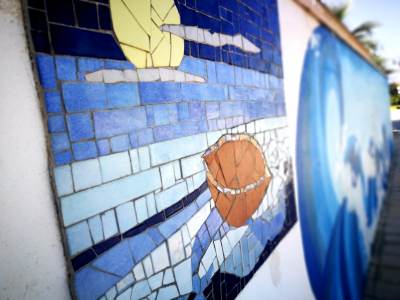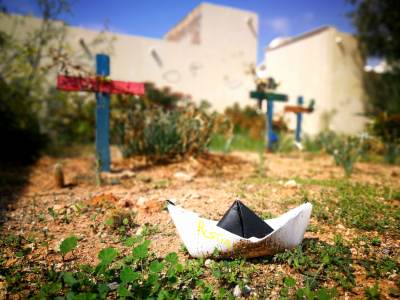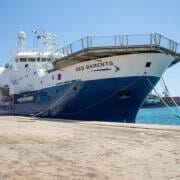Violence and resistance in the Sicilian summer
Article first published on September 16, 2021
The Sicilian summer – despite the pandemic – once again saw the issue of immigration at the center of media and political attention, giving life to the usual theater of political accusations and emergency rhetoric. But beyond the political clashes between Lamorgese and Salvini and the paternalistic words of Minniti on how to “manage the African continent”, the Sicilian reality tells of new health frontiers, deprivation of rights, death, but also and most importantly of resistance.
News from the smaller islands
The summer began with yet another tragedy. On the night between 29 and 30 June, a boat was wrecked a few miles off the coast of Lampedusa. Nine people lost their lives, most of them women, and the bodies – although identified – have not yet been recovered.
From July onwards, in Lampedusa, the hotspot-quarantine ship system went into crisis because the many landings, often autonomous ones, filled both the hotspot and the ships, which led to the overcrowding of structures on the ground, such as Villa Sikania to the point that direct transfers with patrol boats to Pozzallo were cut off. At the end of August, the number of people in the hotspot was close to 1,500 and there was talk of health risks inside the hotspot, as reported by Legambiente, since an open landfill was created in the Contrada Imbriacola valley. In fact, most public statements focused on the fact that “the sewage of those suffering from Covid-19, diphtheria and, in the past, also tuberculosis also ends up in the sewage system”.
As long as it is “only” the health of the people inside the hotspot that is at risk, it does not matter, but when tourism and so-called public health are at risk – which must be protected from “foreign diseases” – then it is worth taking an interest in the situation. Moreover, despite the presence of over 60,000 additional people during the summer and the already poor sewerage system (which had broken out in other areas of the island due to unregulated management of tourism), once again, in the surreal political-institutional debate in Lampedusa, the news was only that of the “public health risk” linked to the hotspot.
Lampedusa was not the only island where boats and people arrived. The socio-economic and political situation in Tunisia has in fact led to the intensification of travel on less used routes in recent years. While in winter and spring the landings in Pantelleria had significantly increased compared to recent years, this summer also on the island of elite tourism there has been talk of “emergency landings”. Although the rescue center on the island, (set up in an abandoned former military base), is a tiny space with hygienic levels even when it is empty, and still does not have a defined legal status, this summer the number of refugees peaked at 200 people. The mayor of Pantelleria was seen shouting “they want to make the island a refugee camp and I will oppose with all my strength“, while the political opposition forces called for “the use of the Italian army for constant and continuous surveillance of the center“.
On the other hand, one could wonder how on an internationally renowned island where tourists arrive, and whose branding is grounded in being an unreachable and therefore chic island, having to deal with those arriving from the sea and from the south is so impossible? This is also because, as in Lampedusa, the walls of these centers which aim at excluding are actually full of “holes”, from which people come out independently and with absolutely non-calamitous intentions: buy a pack of cigarettes, take a walk, look for a phone to call home.
If Pantelleria has consolidated itself as an island of migration, this summer there have also been some autonomous landings in Marettimo and Levanzo, as well as in several other areas of southern Italy, starting with Sardinia, but also in Calabria and Puglia.
Resist the quarantine device
In August, a group of people who had been transferred from Lampedusa to Augusta were put on a quarantine ship. However, the people claimed that they had already done the quarantine period in Lampedusa and rebelled, starting to resist the attempt to get them on board and, once on the ship, they continued to protest. It is not new that the arbitrary practices of the Sicilian prefectures and the police have found in the “protection of health” a new strategy of discrimination and violence against those arriving by sea in Sicily. But the active resistance of migrants, together with the pressures of civil society, is the only way to make the suffering inflicted by this confinement system known to the outside world.
In mid-July, during a protest that broke out inside the Pozzallo hotspot (used in the last year as a quarantine center) some mattresses were set on fire and, out of the 120 people present, 30 managed to escape, some of whom have yet to be found. The resistance of migrant people imprisoned in these ambiguous places (who wants to protect health by gathering people in a center with bars, barbed wire and cameras?) is a resistance in which people put their lives at risk which is being described by newspapers and institutions as simple acts of vandalism.
There have been many more episodes of escapes and resistance this summer: from Villa Sikania, from Villaggio Mosé, from the center of the Cifali district in the Ragusa area. Material conditions of life are degrading in those quarantine or extraordinary reception centers where time stops for people – it is “stolen” from them – despite the fact that PCR tests have often been negative for several days. Additionally, out of all the people arriving, this summer, Tunisians were the ones who were most targeted there, criminalized and deported within a few weeks.
The German choice (and its hypocrisies)
In this context, a German court blocked the refoulement to Italy – country of first landing and in which they should have been “dublined” – of two people originally from Mali and Somalia. The reasoning for the court is that “in Italy there is a high risk that the authorities will not be able to meet basic needs such as bed and board”. The decision was also rendered on the basis of a report written by borderline-europe and the Swiss refugee aid (SFH). In light of what has been happening in Sicily and throughout Italy for years, such a ruling should not come as a surprise, and it is not even the first time that a country of first landing has been considered “unsafe”.
It has happened and continues to happen cyclically in Greece and it has already happened in Italy as well. While not the first ruling of such nature, it is the first during the pandemic and could set a precedent for other cases in this context. What we want to underline, however, is another aspect. As we have been able to show, together with other associations, in the “Eu Ad Hoc Relocations” Report, in recent years Germany has dealt with Italy and Greece in a very different way: in fact, people coming from these countries have been relocated to Germany. These people are originating from countries with which Germany had repatriation agreements, so that the rate of rejection of asylum and residence permit applications for this specific category of people was higher than 80%. Thus, instead of guaranteeing rights in the name of a national solidarity, the targeted agreements prevent the benefit of such rights.
Prospects for the year to come
The events of this summer serve to relaunch a civil mobilization and activism program that supports the mobility of people crossing the Mediterranean, starting with Tunisian people who are out of all, the most criminalized and left to die at sea. As part of this mobilization it is therefore also necessary to support the efforts of Tunisian mothers and women in search of the truth about the deaths of their families, which in the first place means knowing where their bodies are. Cooperation between the two shores of the Mediterranean is essential to combat this system.
However, it is also important to look at what continues to move on this island. The two CPR of Trapani Milo and Caltanissetta Pian del Lago have reopened. The monitoring of civil society is essential to help those who find themselves locked up in these places as well as to report the violence that takes place in the centers. And with this in mind, great attention will also be needed on the Cara di Mineo, where, after the arrival of 700 people from Afghanistan at the Sigonella base, two cleaning and renovation companies are working to redevelop the buildings in the center, although it is not clear for what purposes.
Last, but not least, in this summer of tourism boom in the region, the situation of workers in the agricultural sector – the beginning of the olive harvest in Campobello is upon us –, but also of all workers. and women workers who have found a job – often irregular – in the backs of kitchens or in the tourism sector must be watched carefully.
Borderline Sicily editorial staff
Translated from Italian by Anna Doumbia




